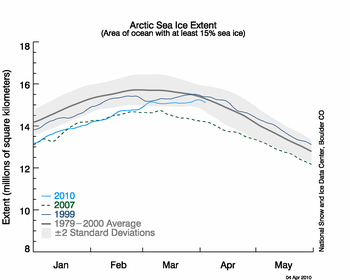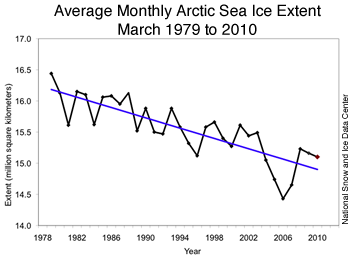April 6, 2010
Cold snap causes late-season growth spurt
Arctic sea ice reached its maximum extent for the year on March 31 at 15.25 million square kilometers (5.89 million square miles). This was the latest date for the maximum Arctic sea ice extent since the start of the satellite record in 1979.
Early in March, Arctic sea ice appeared to reach a maximum extent. However, after a short decline, the ice continued to grow. By the end of March, total extent approached 1979 to 2000 average levels for this time of year. The late-season growth was driven mainly by cold weather and winds from the north over the Bering and Barents Seas. Meanwhile, temperatures over the central Arctic Ocean remained above normal and the winter ice cover remained young and thin compared to earlier years.
Overview of conditions
Arctic sea ice extent averaged for March 2010 was 15.10 million square kilometers (5.83 million square miles). This was 650,000 square kilometers (250,000 square miles) below the 1979 to 2000 average for March, but 670,000 square kilometers (260,000 square miles) above the record low for the month, which occurred in March 2006.
Ice extent was above normal in the Bering Sea and Baltic Sea, but remained below normal over much of the Atlantic sector of the Arctic, including the Baffin Bay, and the Canadian Maritime Provinces seaboard. Extent in other regions was near average.

March 2010 compared to past years
The average ice extent for March 2010 was 670,000 square kilometers (260,000 square miles) higher than the record low for March, observed in 2006. The linear rate of decline for March over the 1978 to 2010 period is 2.6% per decade.

EDIT
http://nsidc.org/arcticseaicenews/2010/040610.html